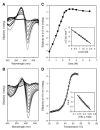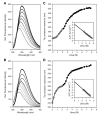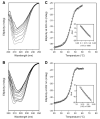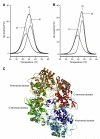Probing the two-domain structure of homodimeric prokaryotic and eukaryotic catalase-peroxidases
- PMID: 20654740
- PMCID: PMC3513708
- DOI: 10.1016/j.bbapap.2010.07.013
Probing the two-domain structure of homodimeric prokaryotic and eukaryotic catalase-peroxidases
Abstract
Catalase-peroxidases (KatGs) are ancestral bifunctional heme peroxidases found in archaeons, bacteria and lower eukaryotes. In contrast to homologous cytochrome c peroxidase (CcP) and ascorbate peroxidase (APx) homodimeric KatGs have a two-domain monomeric structure with a catalytic N-terminal heme domain and a C-terminal domain of high sequence and structural similarity but without obvious function. Nevertheless, without its C-terminal counterpart the N-terminal domain exhibits neither catalase nor peroxidase activity. Except some hybrid-type proteins all other members of the peroxidase-catalase superfamily lack this C-terminal domain. In order to probe the role of the two-domain monomeric structure for conformational and thermal stability urea and temperature-dependent unfolding experiments were performed by using UV-Vis-, electronic circular dichroism- and fluorescence spectroscopy, as well as differential scanning calorimetry. Recombinant prokaryotic (cyanobacterial KatG from Synechocystis sp. PCC6803) and eukaryotic (fungal KatG from Magnaporthe grisea) were investigated. The obtained data demonstrate that the conformational and thermal stability of bifunctional KatGs is significantly lower compared to homologous monofunctional peroxidases. The N- and C-terminal domains do not unfold independently. Differences between the cyanobacterial and the fungal enzyme are relatively small. Data will be discussed with respect to known structure and function of KatG, CcP and APx.
Copyright © 2010 Elsevier B.V. All rights reserved.
Figures






Similar articles
-
Eukaryotic extracellular catalase-peroxidase from Magnaporthe grisea - Biophysical/chemical characterization of the first representative from a novel phytopathogenic KatG group.Biochimie. 2012 Mar;94(3):673-83. doi: 10.1016/j.biochi.2011.09.020. Epub 2011 Sep 29. Biochimie. 2012. PMID: 21971530 Free PMC article.
-
High conformational stability of secreted eukaryotic catalase-peroxidases: answers from first crystal structure and unfolding studies.J Biol Chem. 2012 Sep 14;287(38):32254-62. doi: 10.1074/jbc.M112.384271. Epub 2012 Jul 20. J Biol Chem. 2012. PMID: 22822072 Free PMC article.
-
New insights into the heme cavity structure of catalase-peroxidase: a spectroscopic approach to the recombinant synechocystis enzyme and selected distal cavity mutants.Biochemistry. 2002 Jul 23;41(29):9237-47. doi: 10.1021/bi025740u. Biochemistry. 2002. PMID: 12119039
-
Probing the structure and bifunctionality of catalase-peroxidase (KatG).J Inorg Biochem. 2006 Apr;100(4):568-85. doi: 10.1016/j.jinorgbio.2006.01.033. Epub 2006 Mar 3. J Inorg Biochem. 2006. PMID: 16516299 Review.
-
Evolution of structure and function of Class I peroxidases.Arch Biochem Biophys. 2010 Aug 1;500(1):45-57. doi: 10.1016/j.abb.2010.03.024. Epub 2010 Apr 4. Arch Biochem Biophys. 2010. PMID: 20371361 Review.
Cited by
-
Deciphering Isoniazid Drug Resistance Mechanisms on Dimeric Mycobacterium tuberculosis KatG via Post-molecular Dynamics Analyses Including Combined Dynamic Residue Network Metrics.ACS Omega. 2022 Apr 7;7(15):13313-13332. doi: 10.1021/acsomega.2c01036. eCollection 2022 Apr 19. ACS Omega. 2022. PMID: 35474779 Free PMC article.
-
Eukaryotic extracellular catalase-peroxidase from Magnaporthe grisea - Biophysical/chemical characterization of the first representative from a novel phytopathogenic KatG group.Biochimie. 2012 Mar;94(3):673-83. doi: 10.1016/j.biochi.2011.09.020. Epub 2011 Sep 29. Biochimie. 2012. PMID: 21971530 Free PMC article.
-
Interaction with the Redox Cofactor MYW and Functional Role of a Mobile Arginine in Eukaryotic Catalase-Peroxidase.Biochemistry. 2016 Jun 28;55(25):3528-41. doi: 10.1021/acs.biochem.6b00436. Epub 2016 Jun 16. Biochemistry. 2016. PMID: 27293030 Free PMC article.
-
High conformational stability of secreted eukaryotic catalase-peroxidases: answers from first crystal structure and unfolding studies.J Biol Chem. 2012 Sep 14;287(38):32254-62. doi: 10.1074/jbc.M112.384271. Epub 2012 Jul 20. J Biol Chem. 2012. PMID: 22822072 Free PMC article.
References
-
- Klotz M, Loewen PC. The molecular evolution of catalatic hydroperoxidases: evidence for multiple lateral transfer of genes between prokaryota and form bacteria into eukaryota. Mol. Biol. Evol. 2003;20:1098–1112. - PubMed
-
- Passardi F, Bakalovic N, Teixeira FK, Margis-Pinheiro M, Penel C, Dunand C. Prokaryotic origins of the non-animal peroxidase superfamily and organelle-mediated transmission to eukaryotes. Genomics. 2007;89:567–579. - PubMed
-
- Zamocky M, Obinger C. Molecular phylogeny of heme peroxidases. In: Ayala M, Torres E, editors. Biocatalysis Based on Heme Peroxidases. Springer; 2010. ISBN: 978-3-642-12626-0.
-
- Passardi F, Zamocky M, Favet J, Jakopitsch C, Penel C, Obinger C, Dunand C. Phylogenetic distribution of catalase-peroxidases: are there patches of order in chaos? Gene. 2007;397:101–113. - PubMed
Publication types
MeSH terms
Substances
Grants and funding
LinkOut - more resources
Full Text Sources
Miscellaneous

